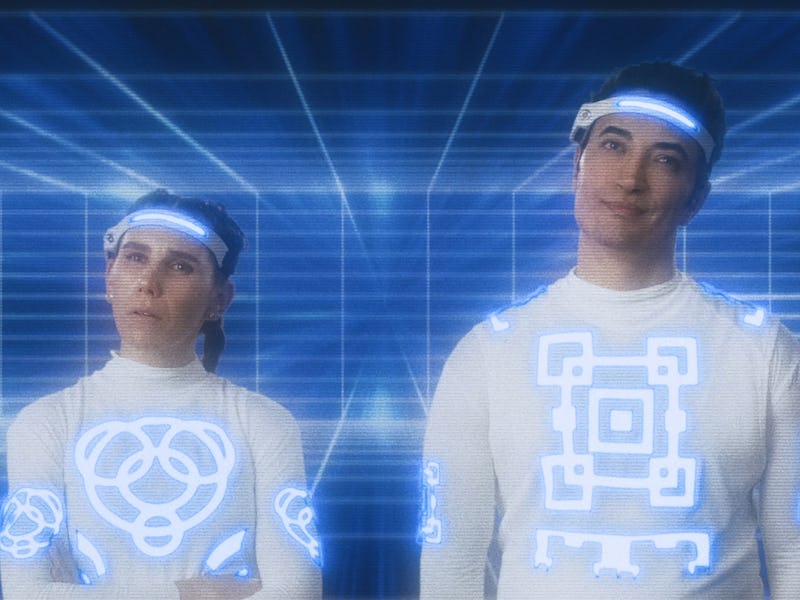Molli and Max in the Future Takes the Rom-Com to Funny New Dimensions
Love is as complicated as the universe in this fresh and inventive microbudget winner.

A truism about romantic comedies is that the question of whether or not its pair of protagonists will get together by the end isn’t really the point. The audience sits down knowing that’s a given; the personality issues getting in the way, and the obstacles placed or thrown in that path, are what really make or break this kind of film. Molli and Max in the Future, the wildly imaginative first feature by Michael Lukk Litwak, nails both, with a pair of charming lead performances and the advantage of having the entire cosmos to get in the way of its lovers’ destiny.
The title suggests a science-fiction spinoff of When Harry Met Sally…, and the film adopts a similar structure to the Rob Reiner/Nora Ephron classic. It brings Molli (Zosia Mamet) and Max (Aristotle Athari) together just long enough for it to become obvious to everyone but them that they’re perfect for each other, then separates and reunites them over long stretches of time. They literally meet by accident, the spacesuited Max winding up on the windshield of Molli’s little spacecraft. She’s in a constant state of spiritual quest, while he aspires to excel in the “super mecha fighter” arena, and though their chemistry is clear, they manage to talk themselves out of pursuing a relationship, and go their separate ways. They will run into each other again repeatedly as the years pass, catching up on life changes, sharing their frustrations, and slowly but surely finding their way to couplehood against a backdrop of strange worlds and dimensions, populated by amusingly odd supporting characters.
From the jazz and big band music on the soundtrack, to the use of chapter intertitles, Molli and Max in the Future is squarely planted in the classic rom-com tradition. One of the key supporting players, the artificial human MAR14 (read that as “Maria,” played by Erin Darke) created by Max, is a straight-up throwback to screwball comedies of the past, with her rat-a-tat delivery, and Litwak has gifted everyone in the film with snappy, witty dialogue that makes them all distinctive. There are plenty of fun throwaway lines that get laughs even as they express character; surprised to be reunited with Molli at one point, Max exclaims, “Oh my science!” Athari has a very likable Brendan Fraser vibe going on in the role, while Molli’s romantic/neurotic nature is put across by Mamet in a thoroughly endearing manner.
Molli and Max in the Future is not just a fresh new twist on the rom-com, it’s a new achievement for micro-budget sci-fi.
The duo banter and spar and reveal themselves to each other against a backdrop of otherworldly environments created by Litwak and his collaborators via largely analog means (which he discusses with Inverse). It’s all clearly low-tech, but that’s part of the movie’s overall design. Items like a VHS player are built into the set pieces, and familiar metropolitan sights like skyscrapers, billboards, subways and sports arenas are imbued with just enough of a touch of the futuristic. Colored lighting schemes reminiscent of the science fiction films of the ’60s enhance the sense of the fantastical surrounding the two leads and their very human issues, while Litwak makes judicious use of shifting aspect ratios to reflect the way his central duo view their lives. Kudos to cinematographer Zach Stoltzfus, production designer Violet Overn, and the rest of the team for making maximal use of minimal funds to immerse us in this fully imagined future.
Crucially, Litwak and co. never stop taking us to new places and introducing us to new faces over the course of Molli and Max, even as its title characters remain squarely at the center of the story and our sympathies. We’re right along with them as their choices and circumstances take them from Megalopolis to Oceanus to The Quantum Zone and elsewhere, each with its own specific look. Among the most noteworthy beings on view is Moebius (Okieriete Onaodowan), guru of an extraterrestrial cult to whom Molli devotes a portion of her life, which includes engaging in carnal activities with one of the tentacles radiating from his giant floating head. (It’s a lot funnier and less gross than that might sound.) Elsewhere, the mecha fighters are animated via stop-motion that will delight fans of that form, and the movie is laced with invented cultural and pop-cultural references (like the omnipresent “Glorp Soda” and its branding) that help solidify the world-building.
Director Michael Lukk Litwak manages to build an original and immersive world through analog technology.
All this detail allows us to become fully invested in the unique universe Litwak has overseen, which makes it easy to engage with Molli and Max as they navigate its many corners and the detours on their way to truly finding each other.